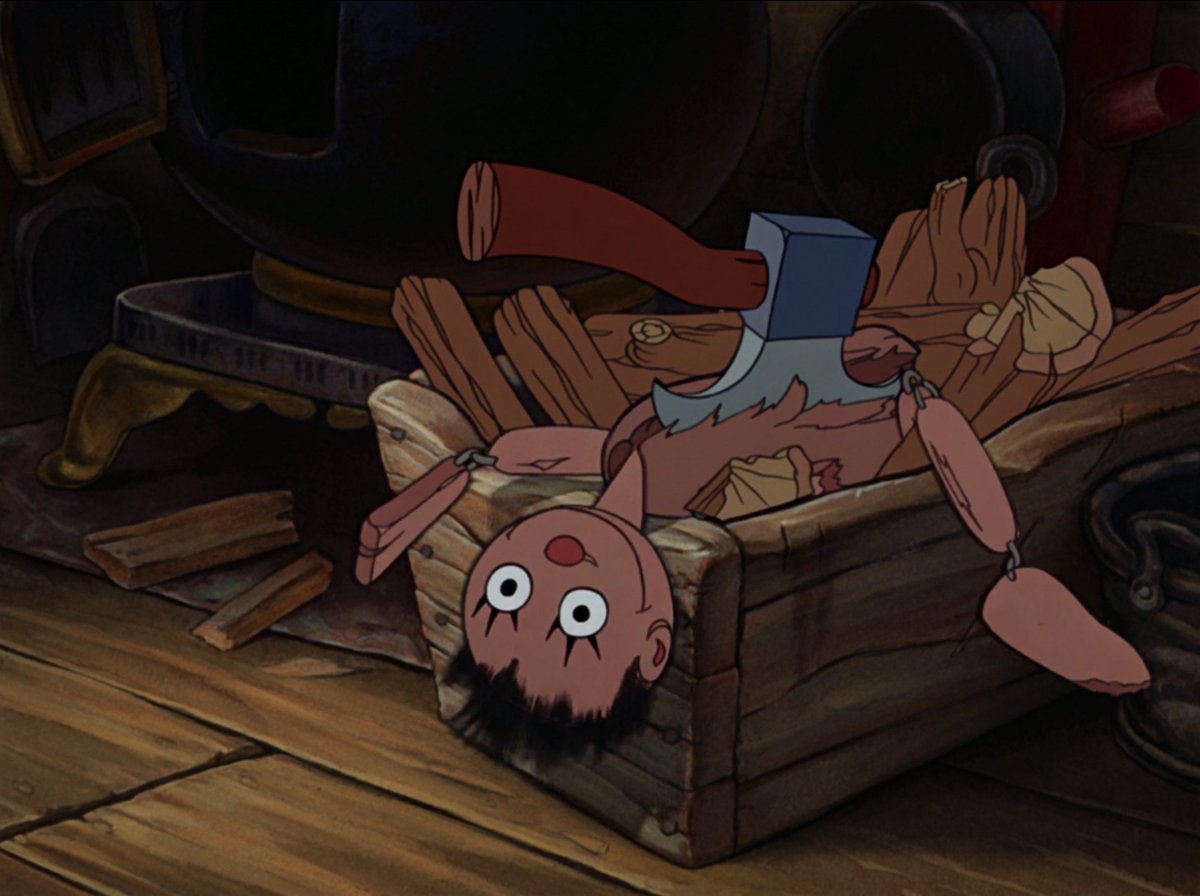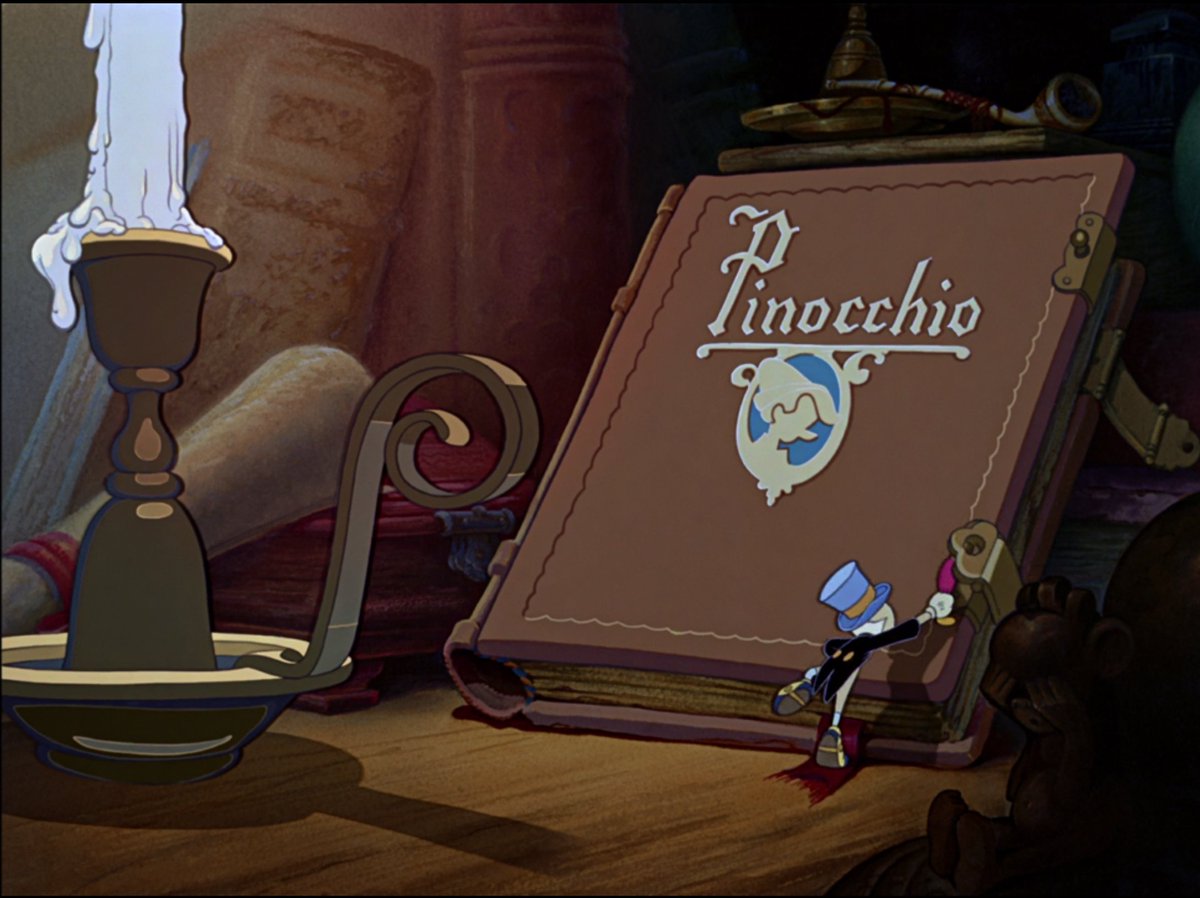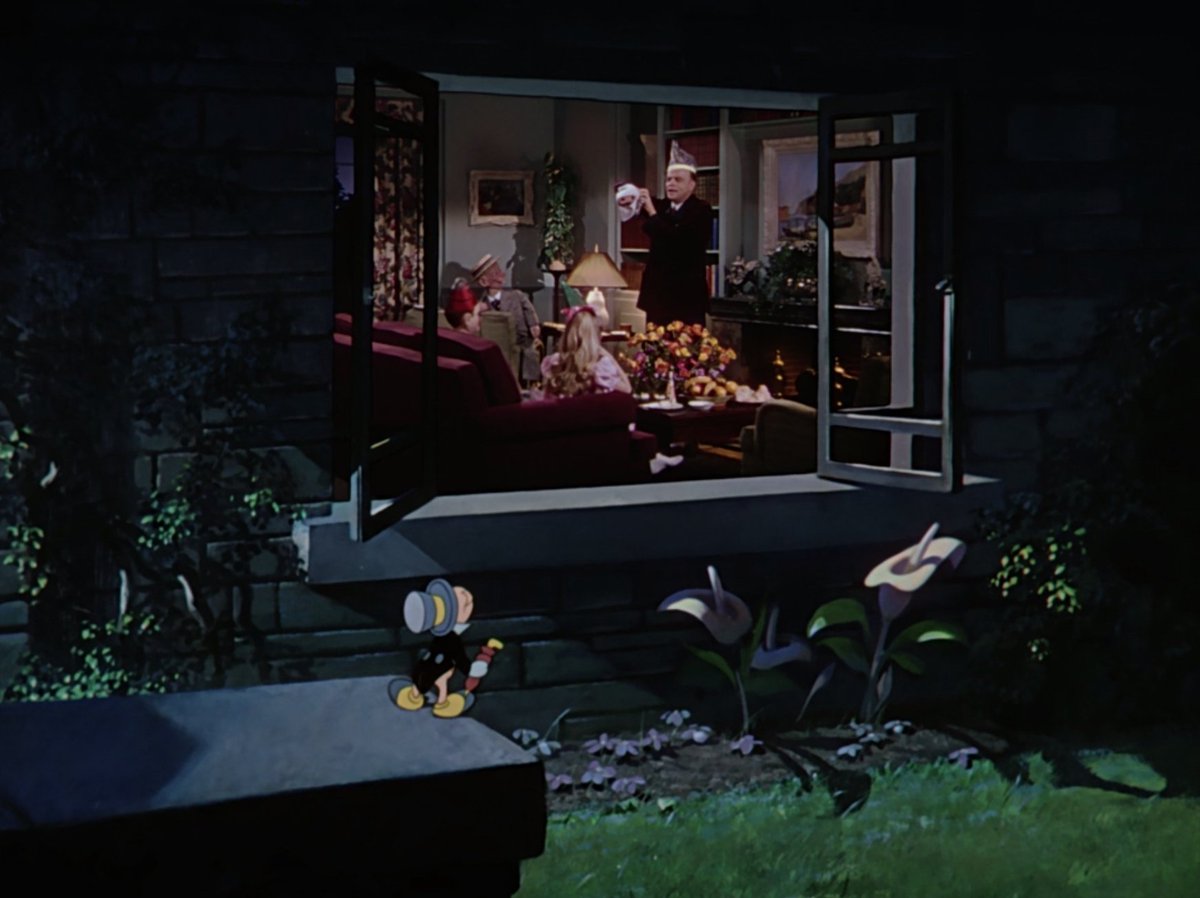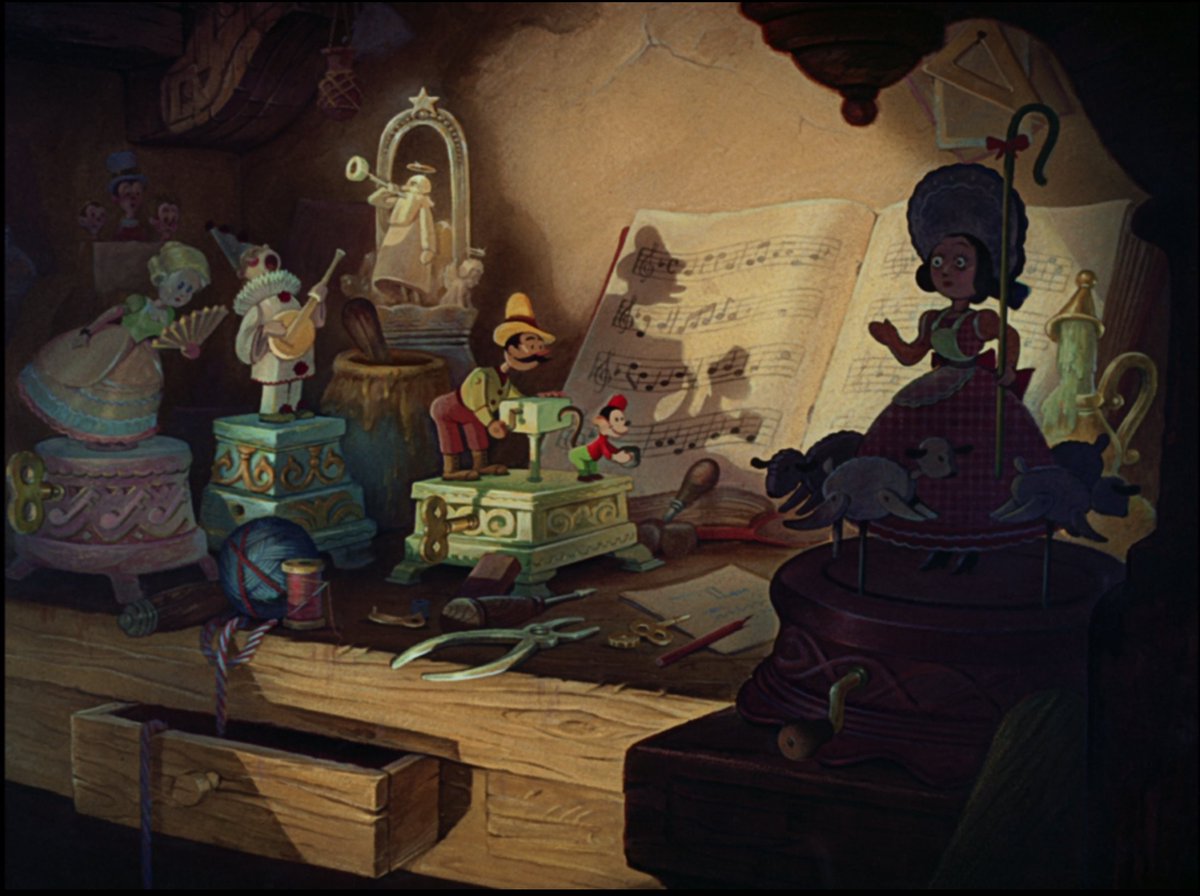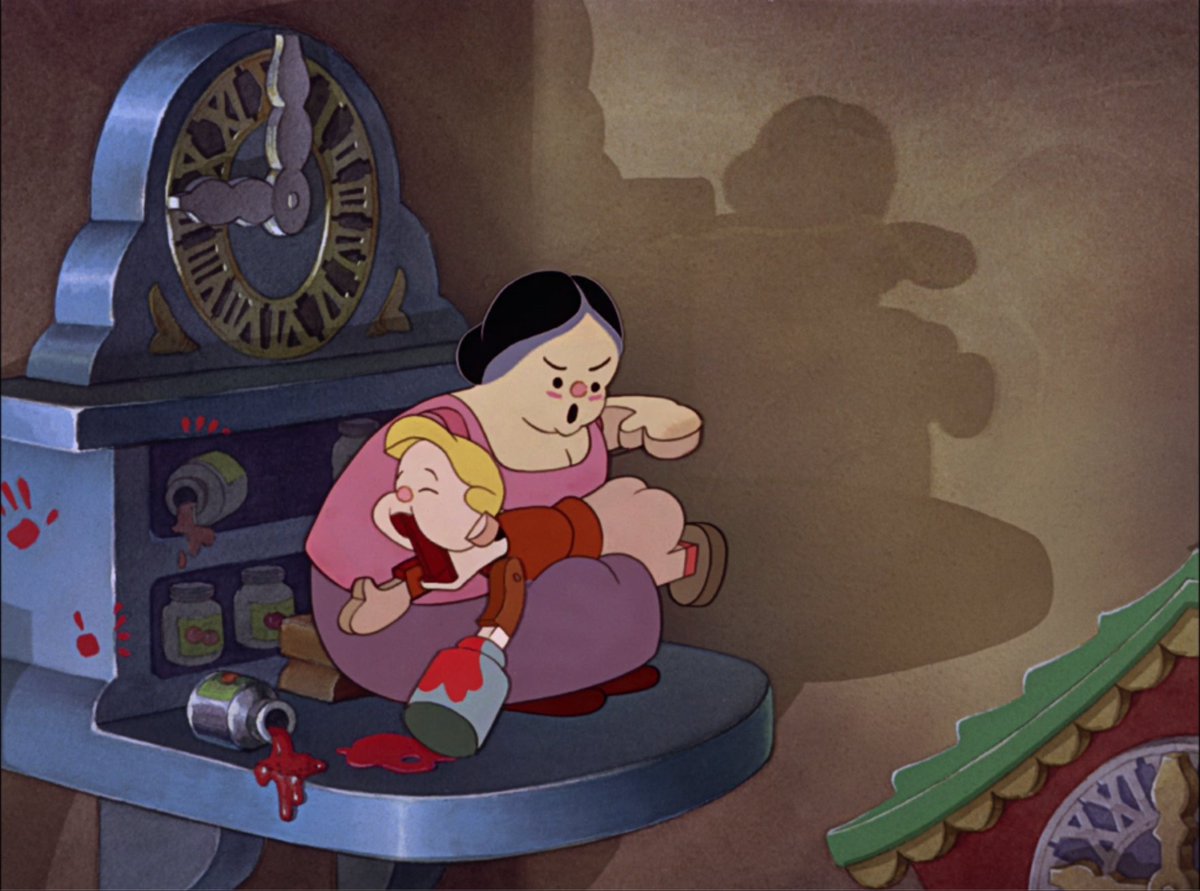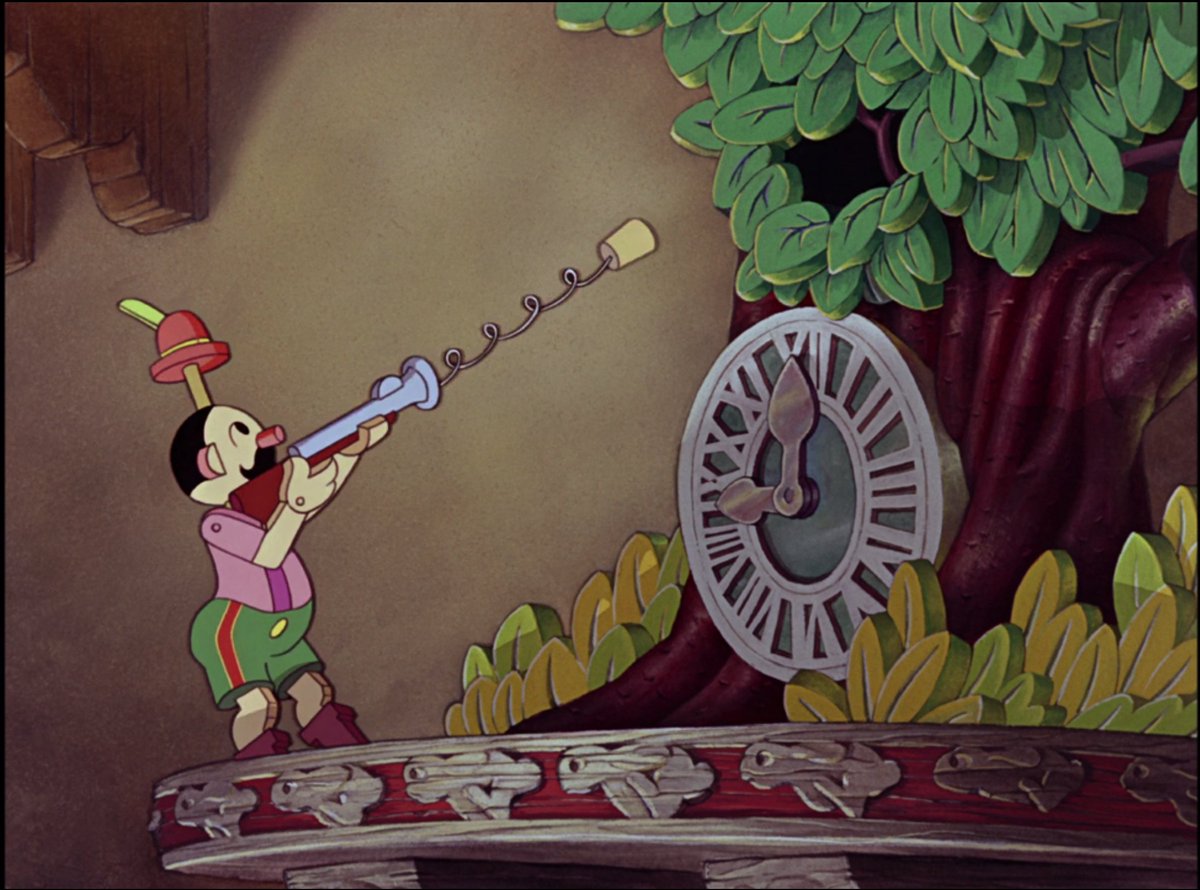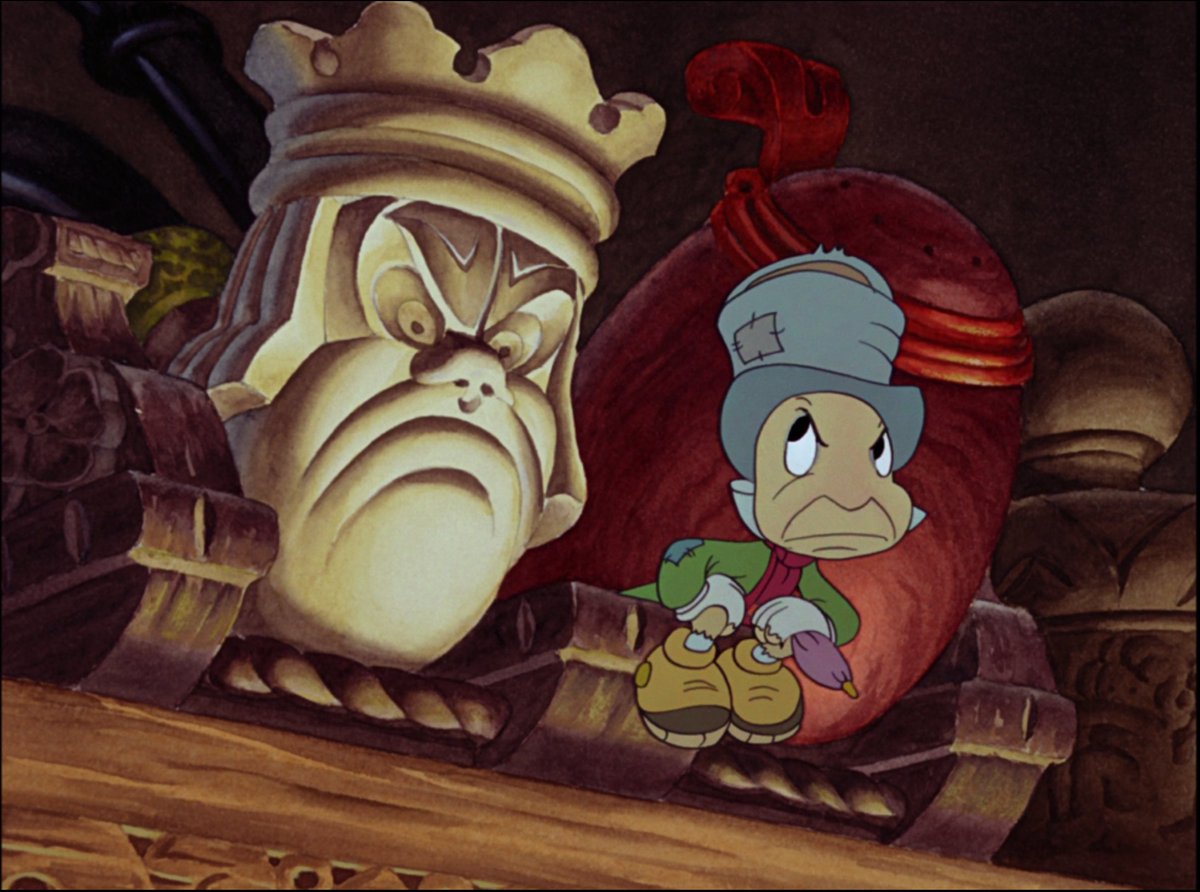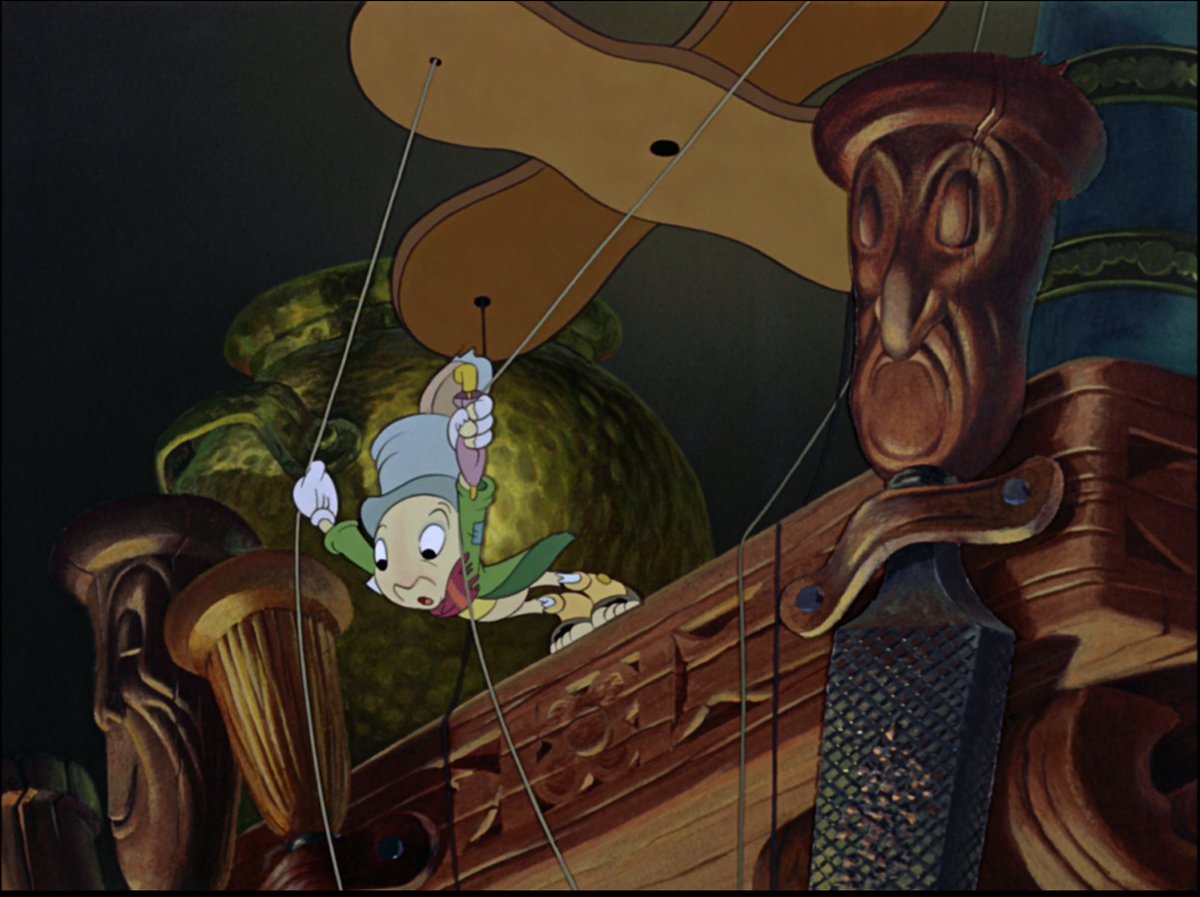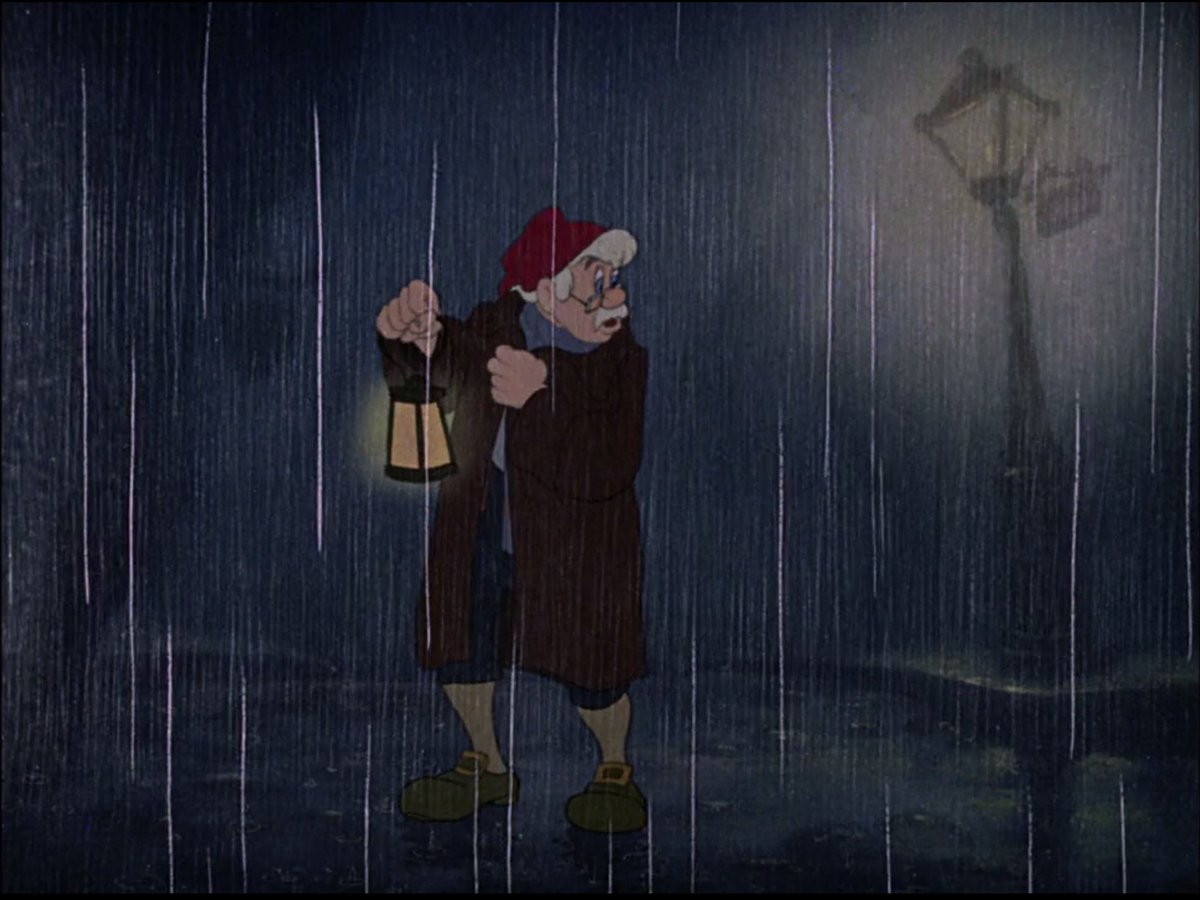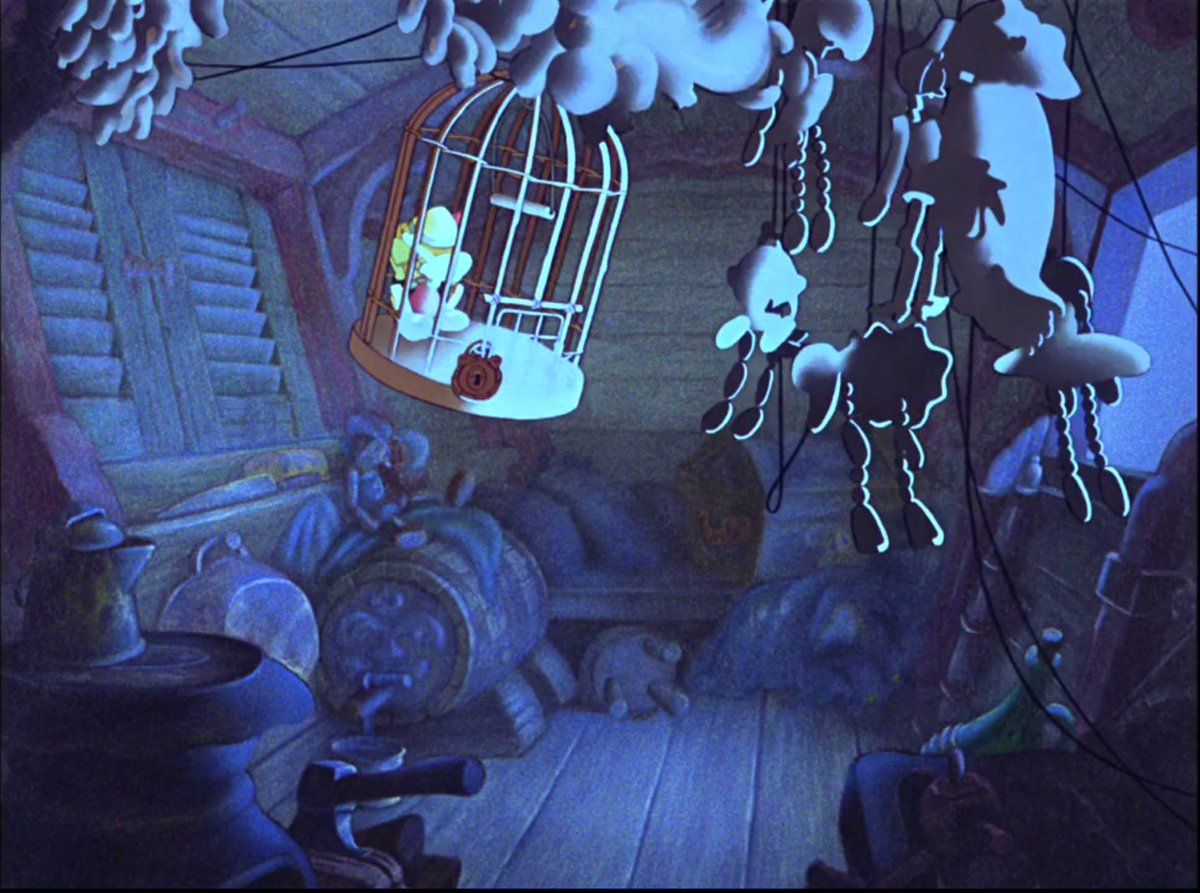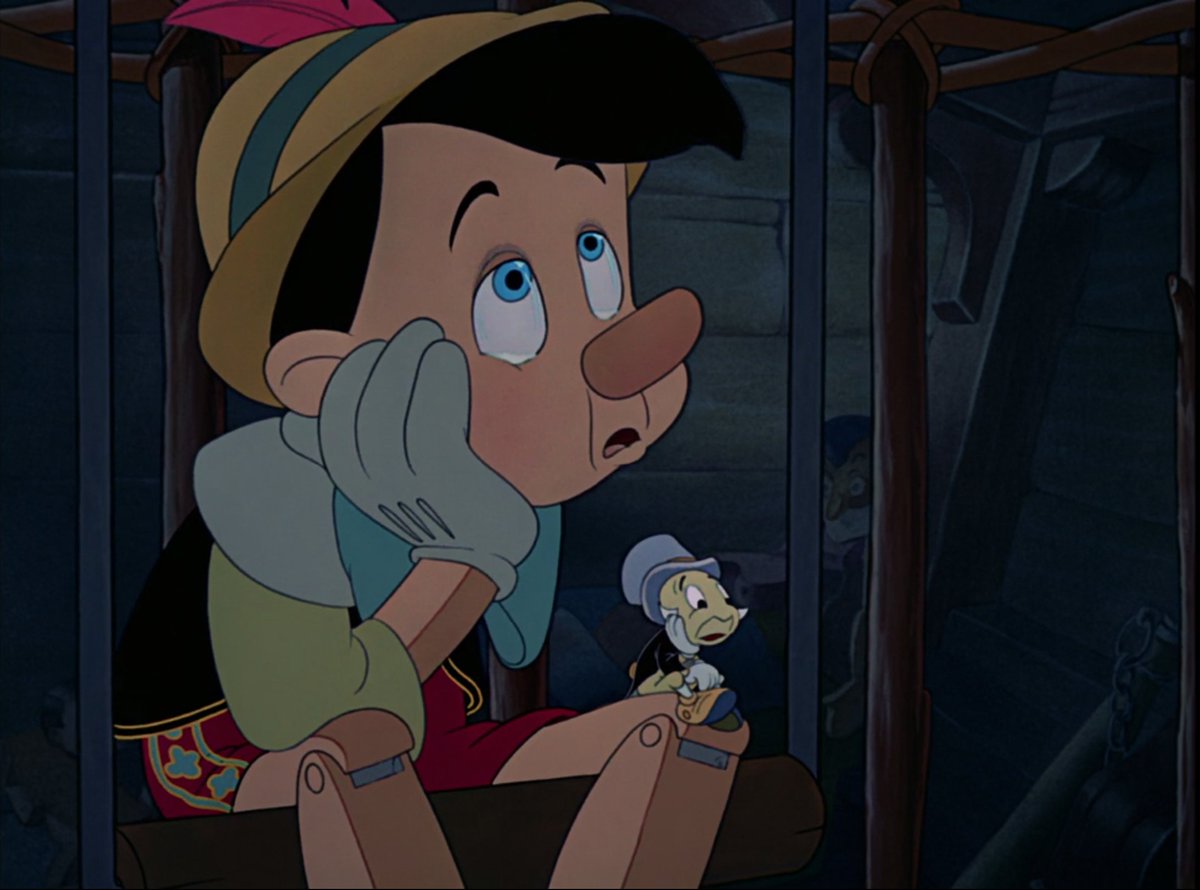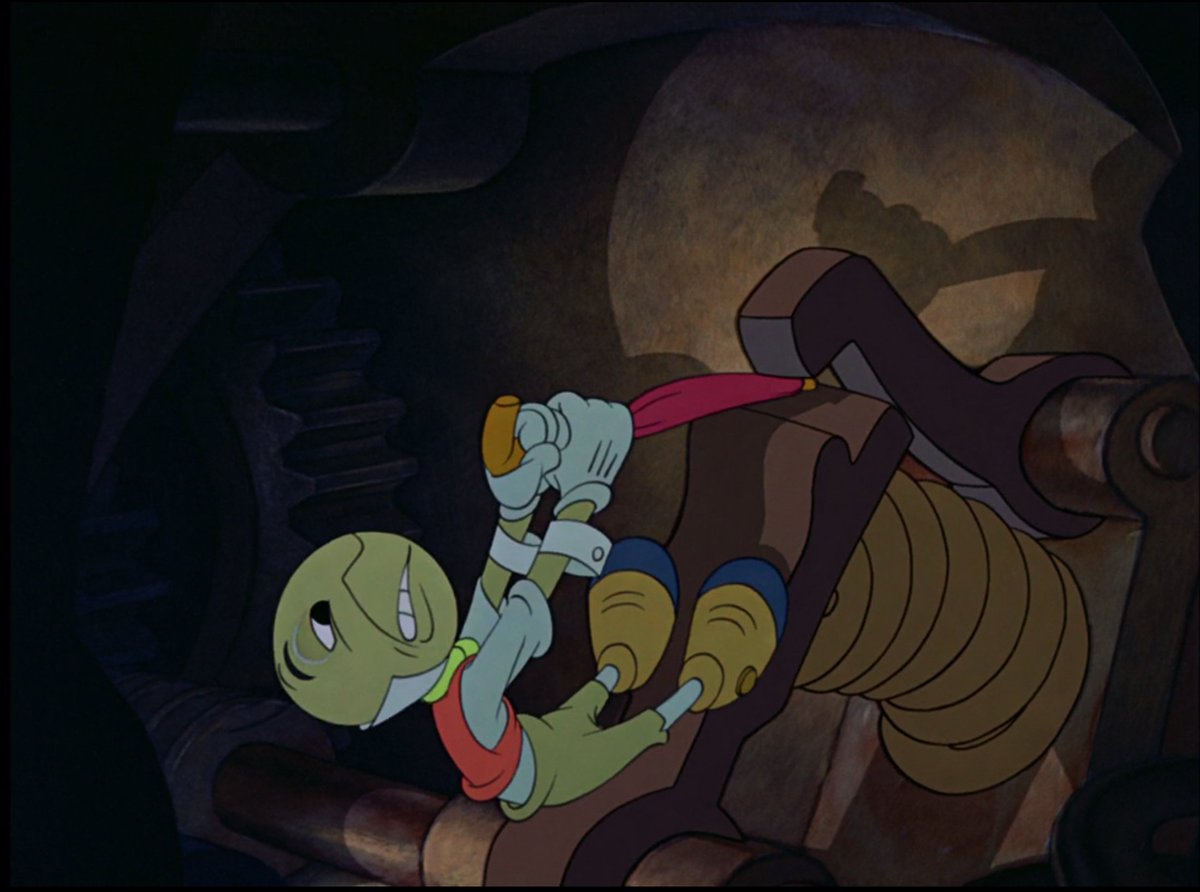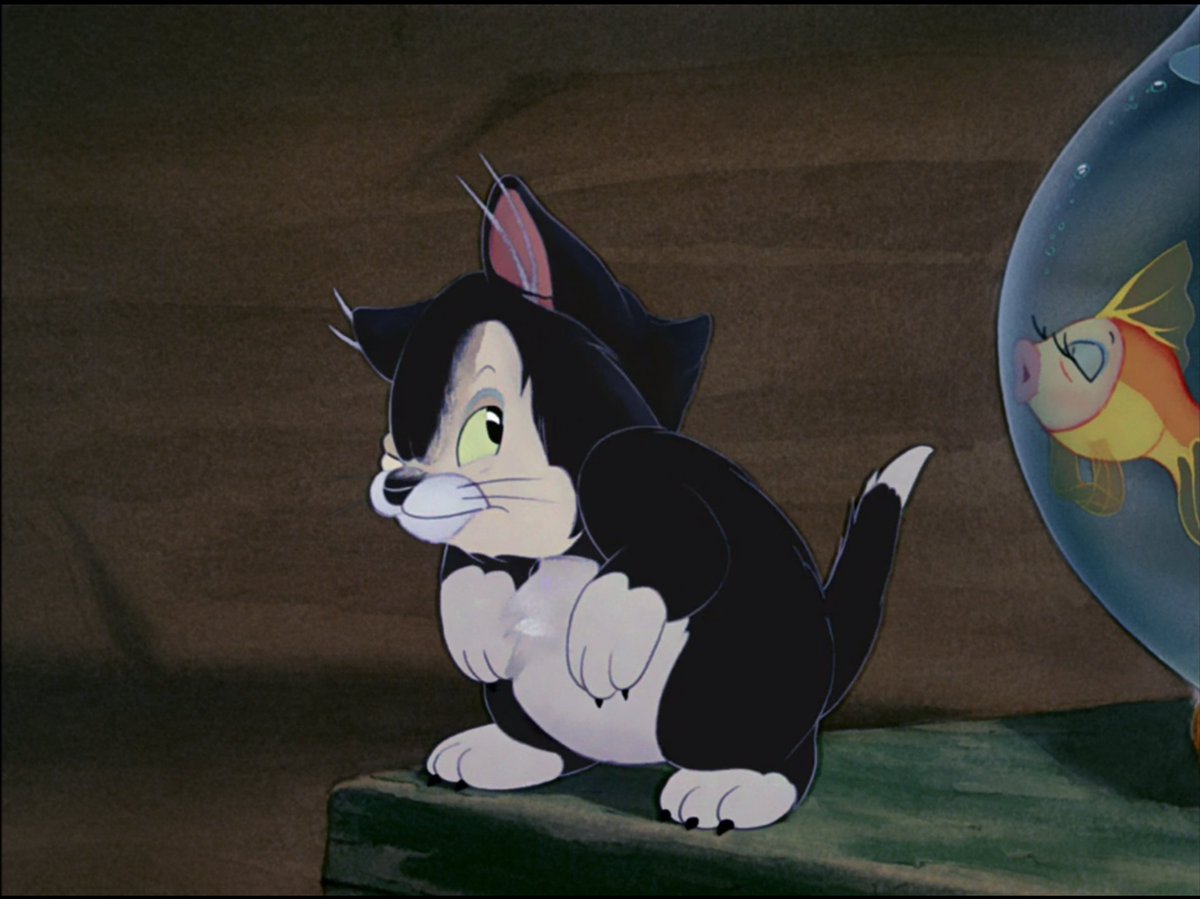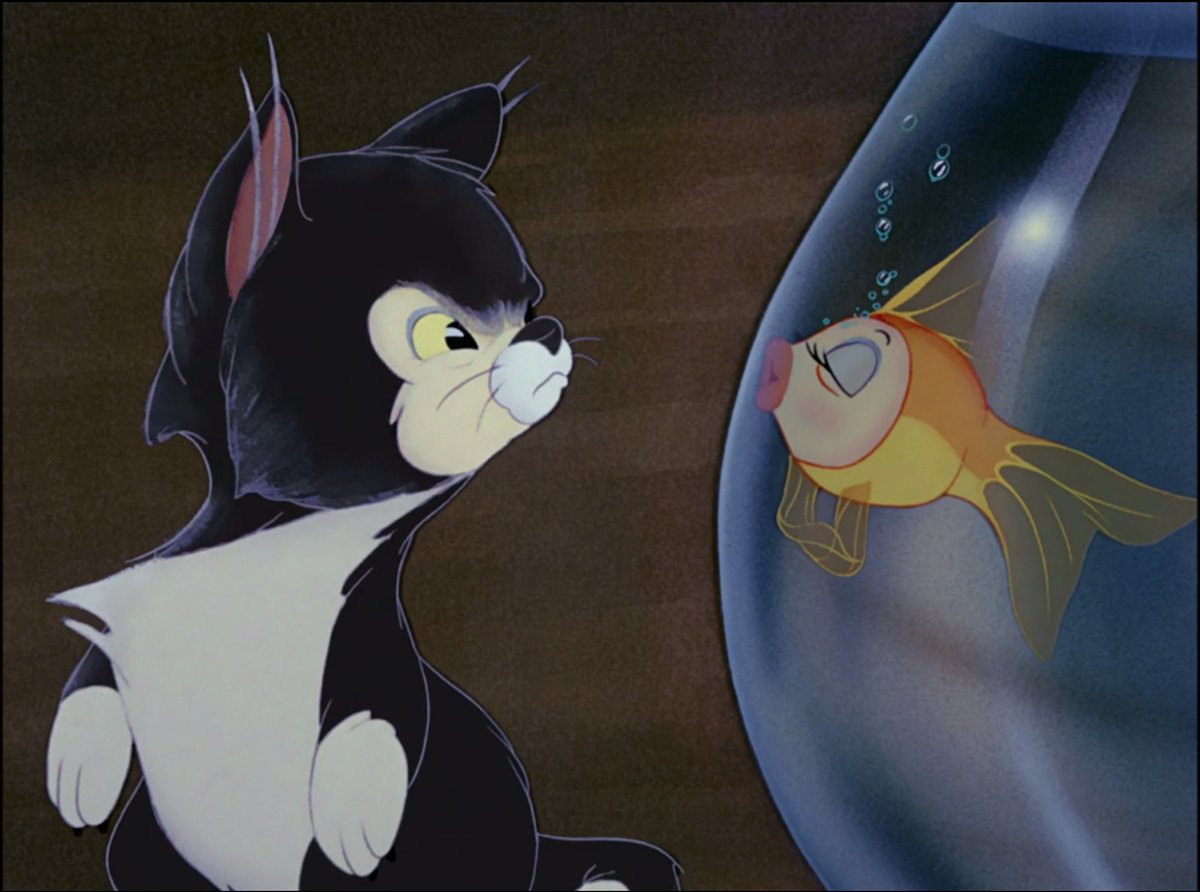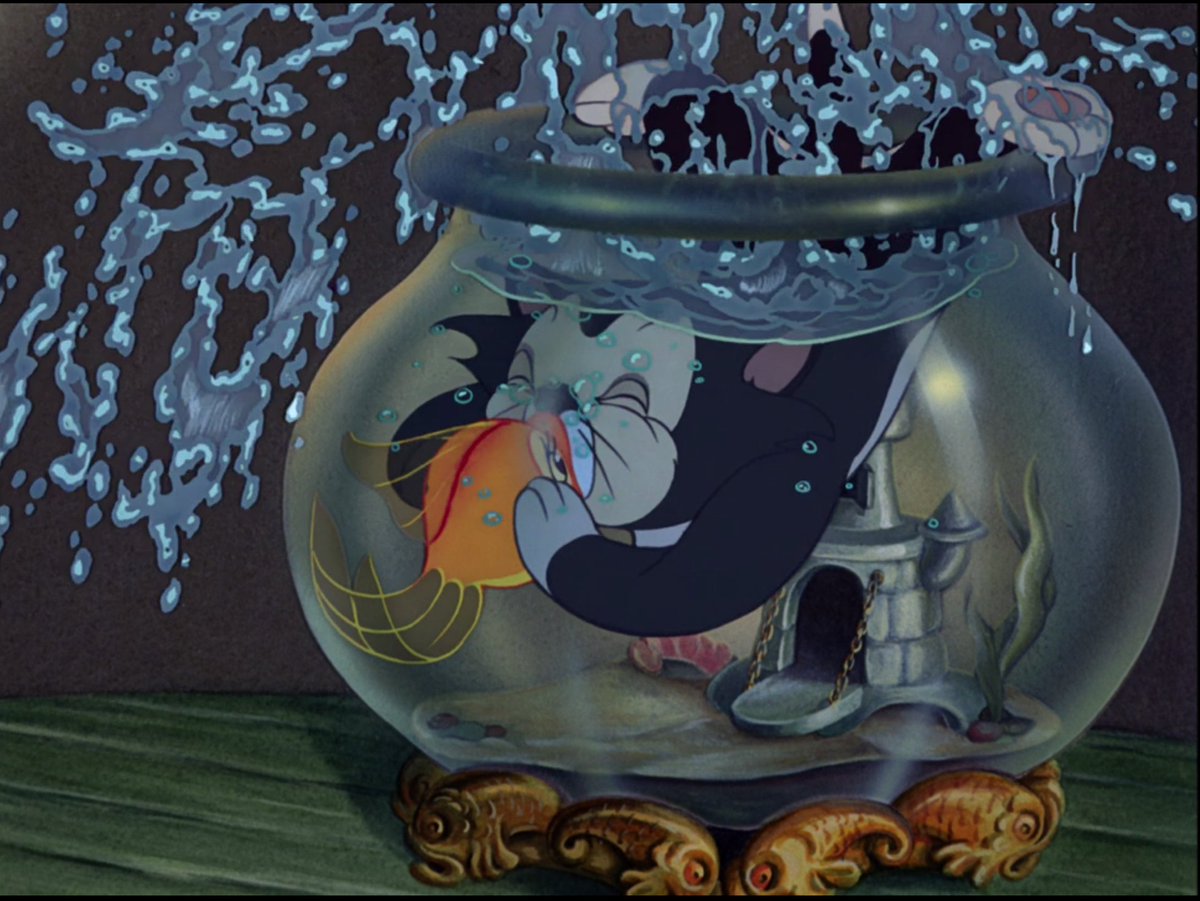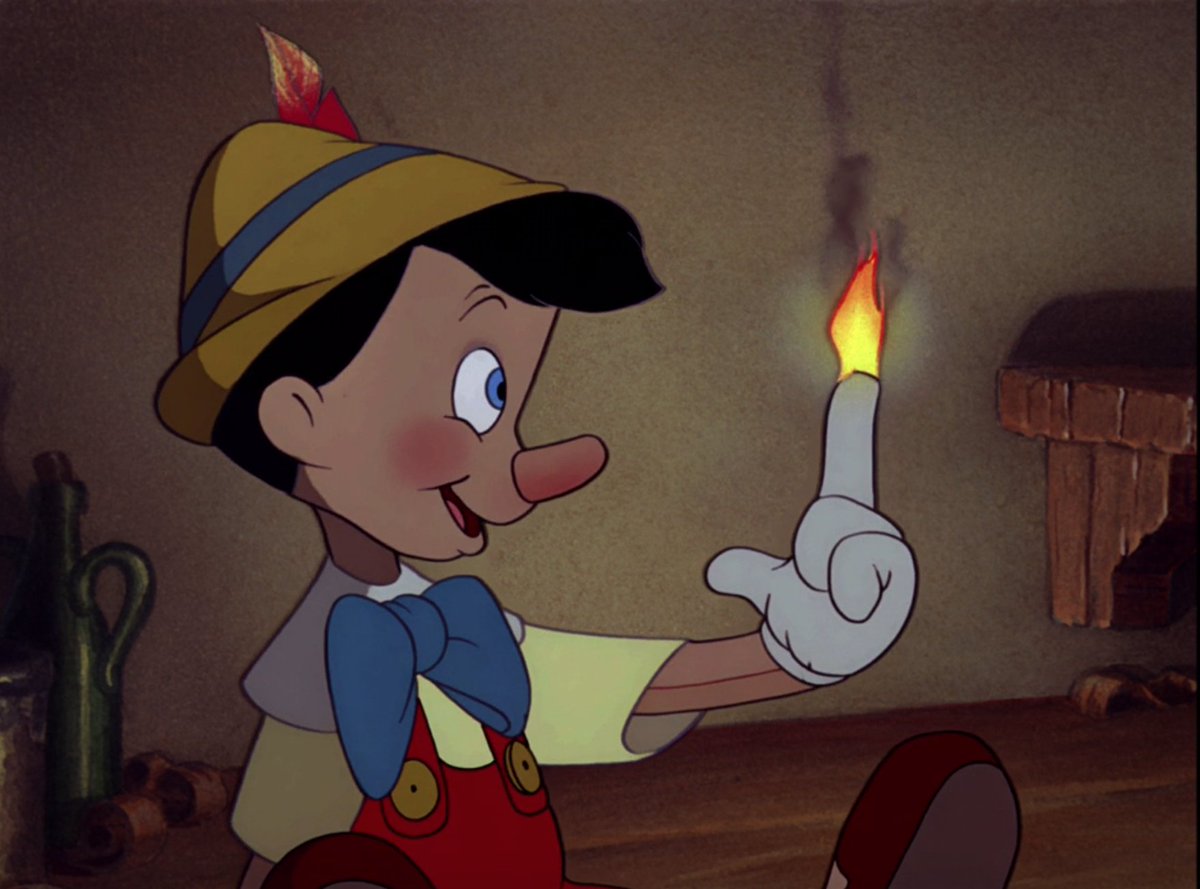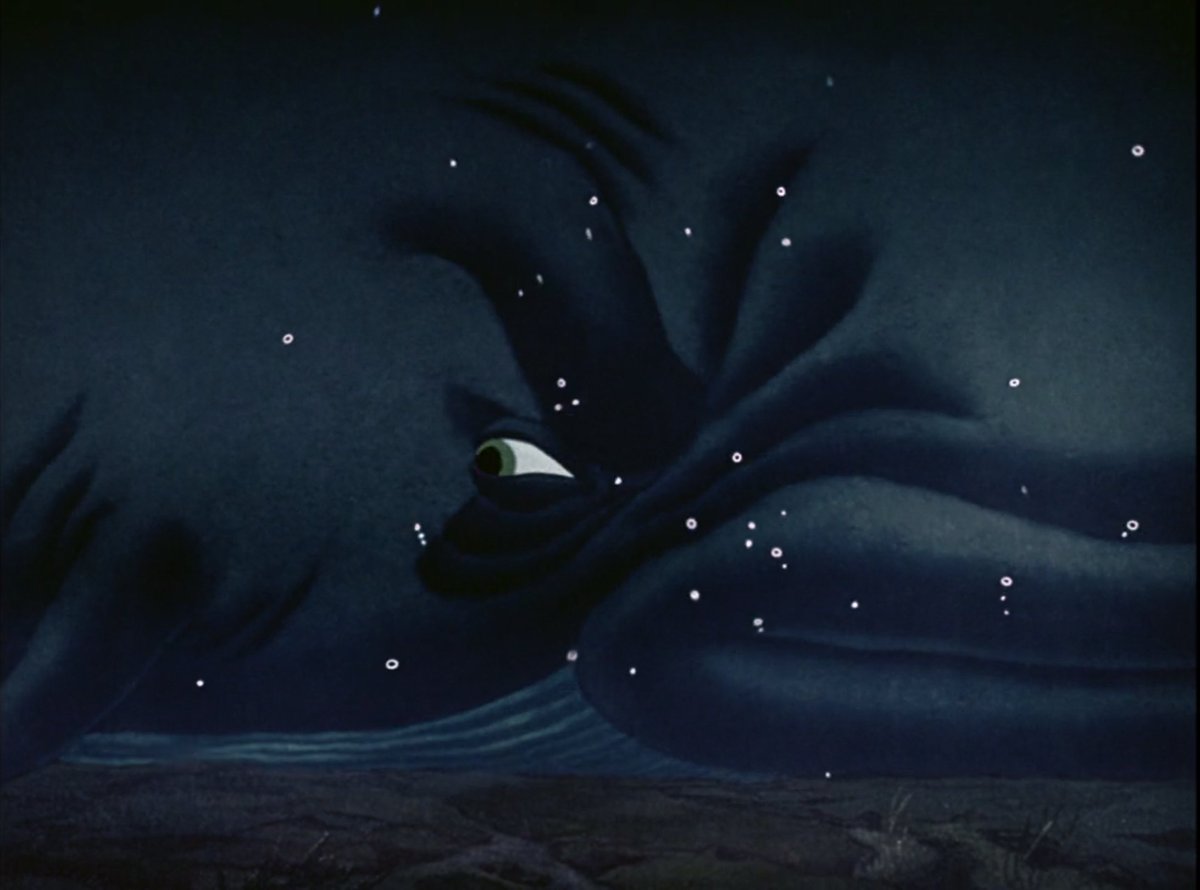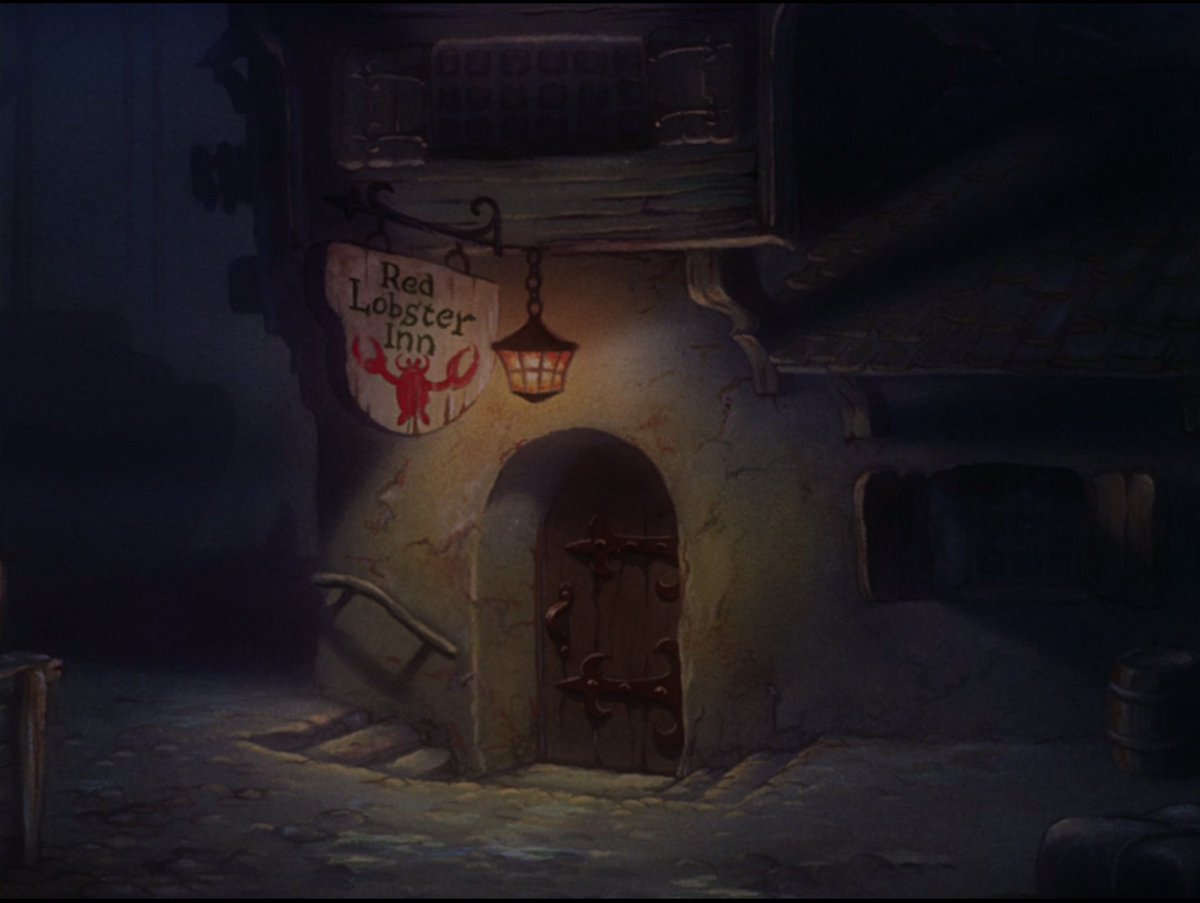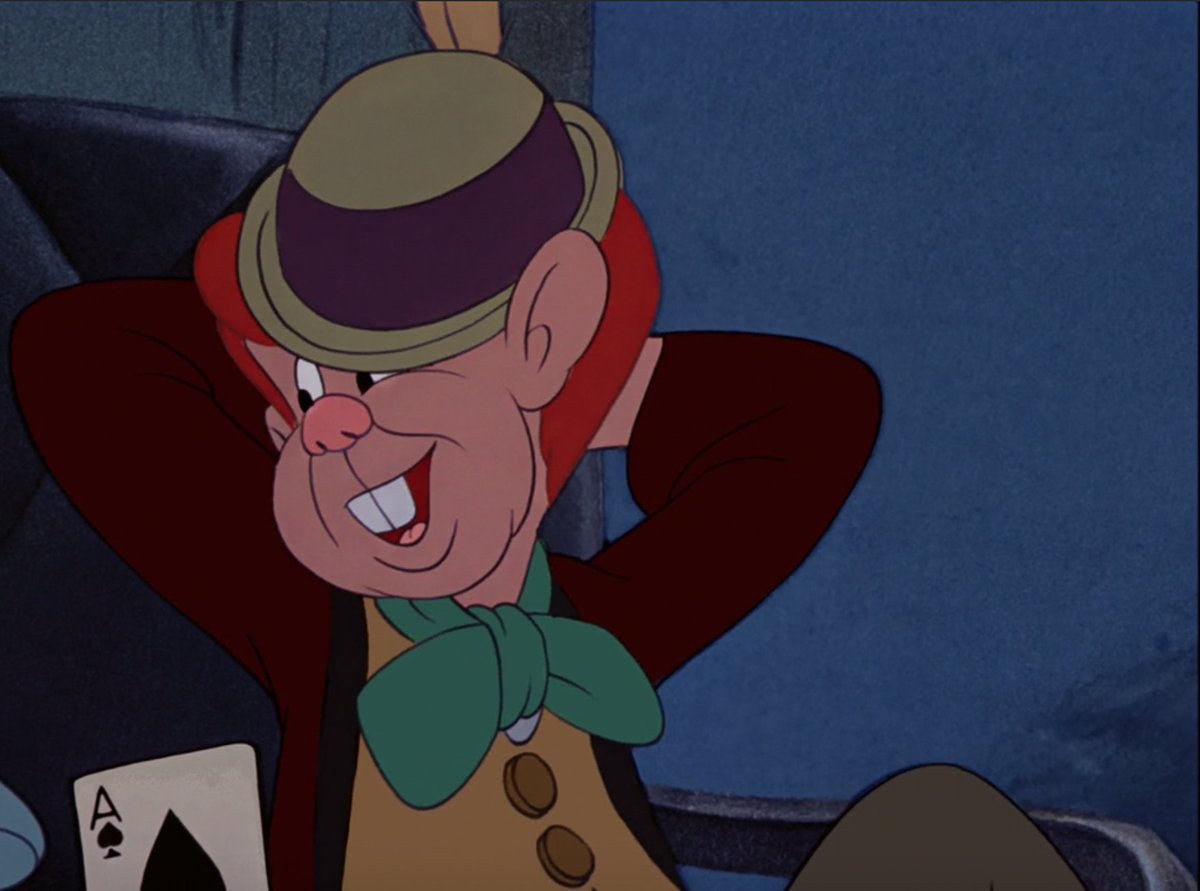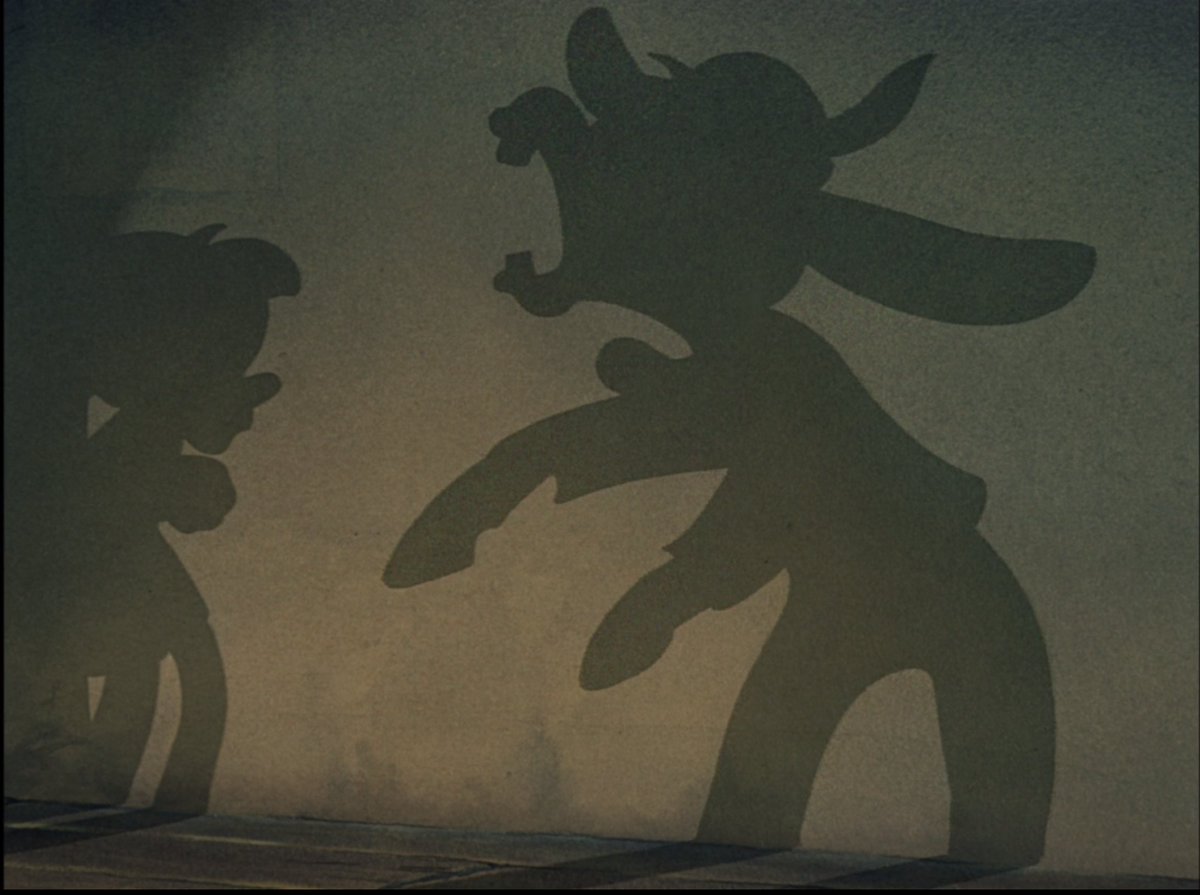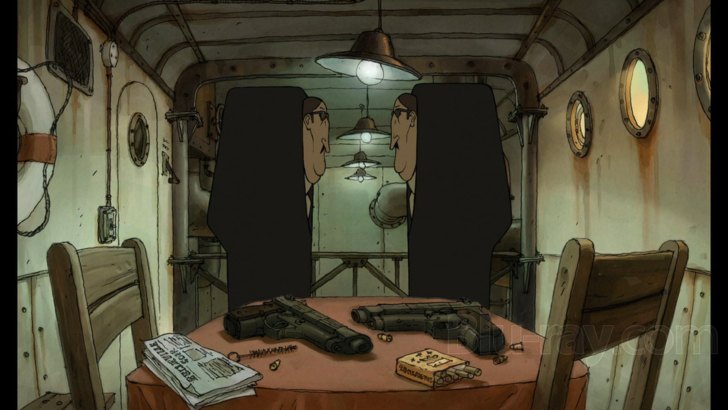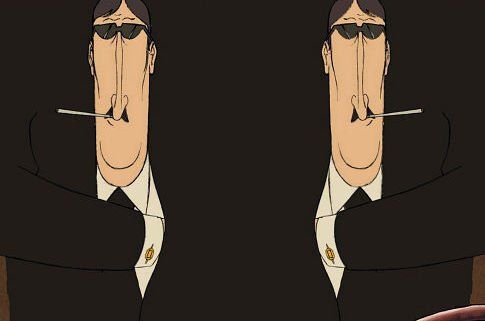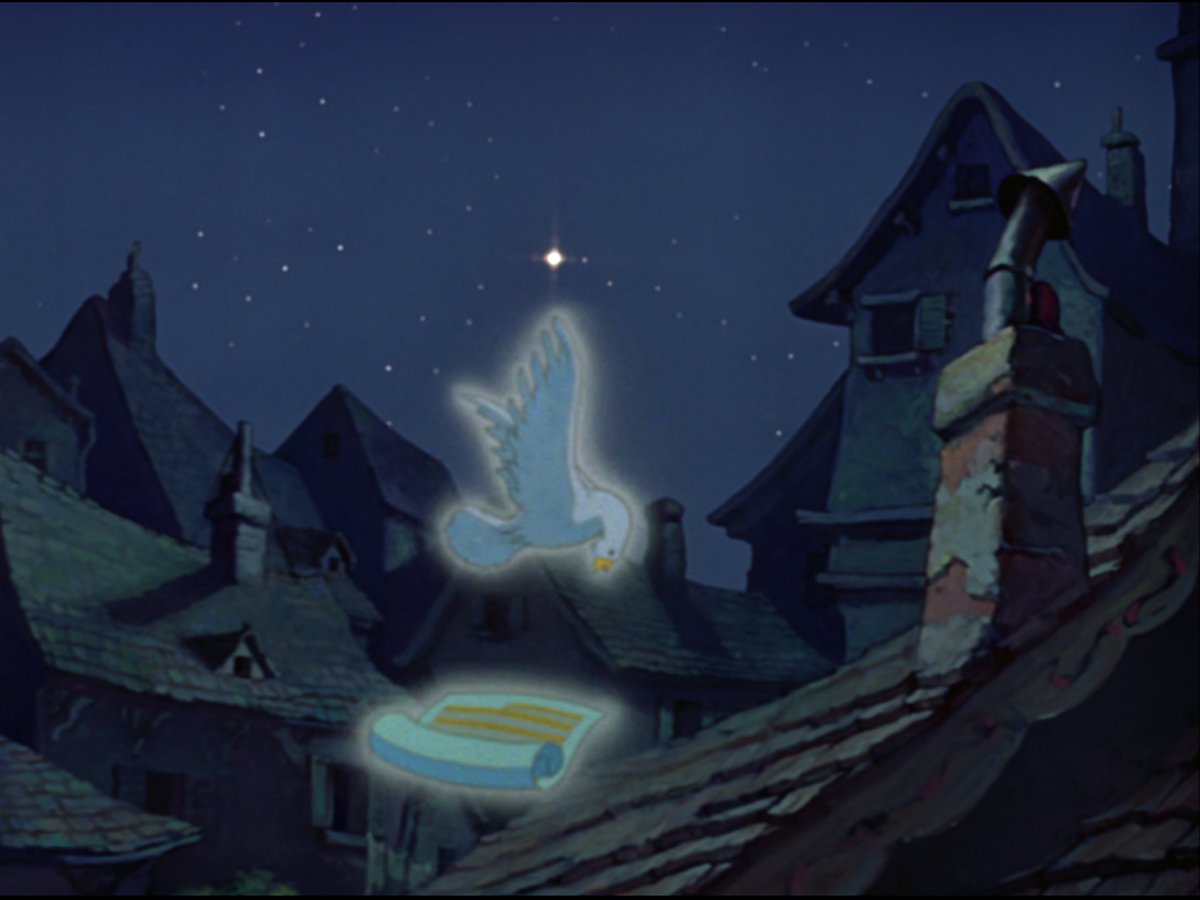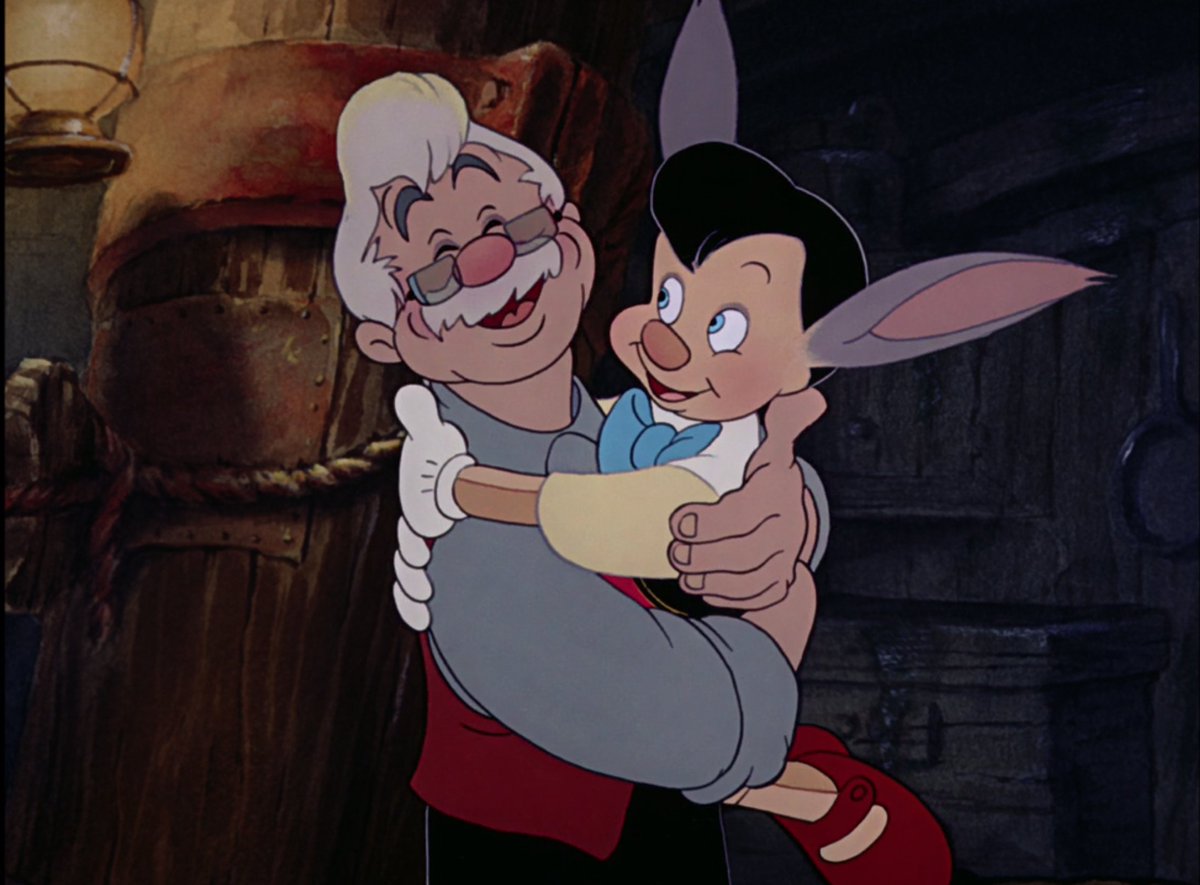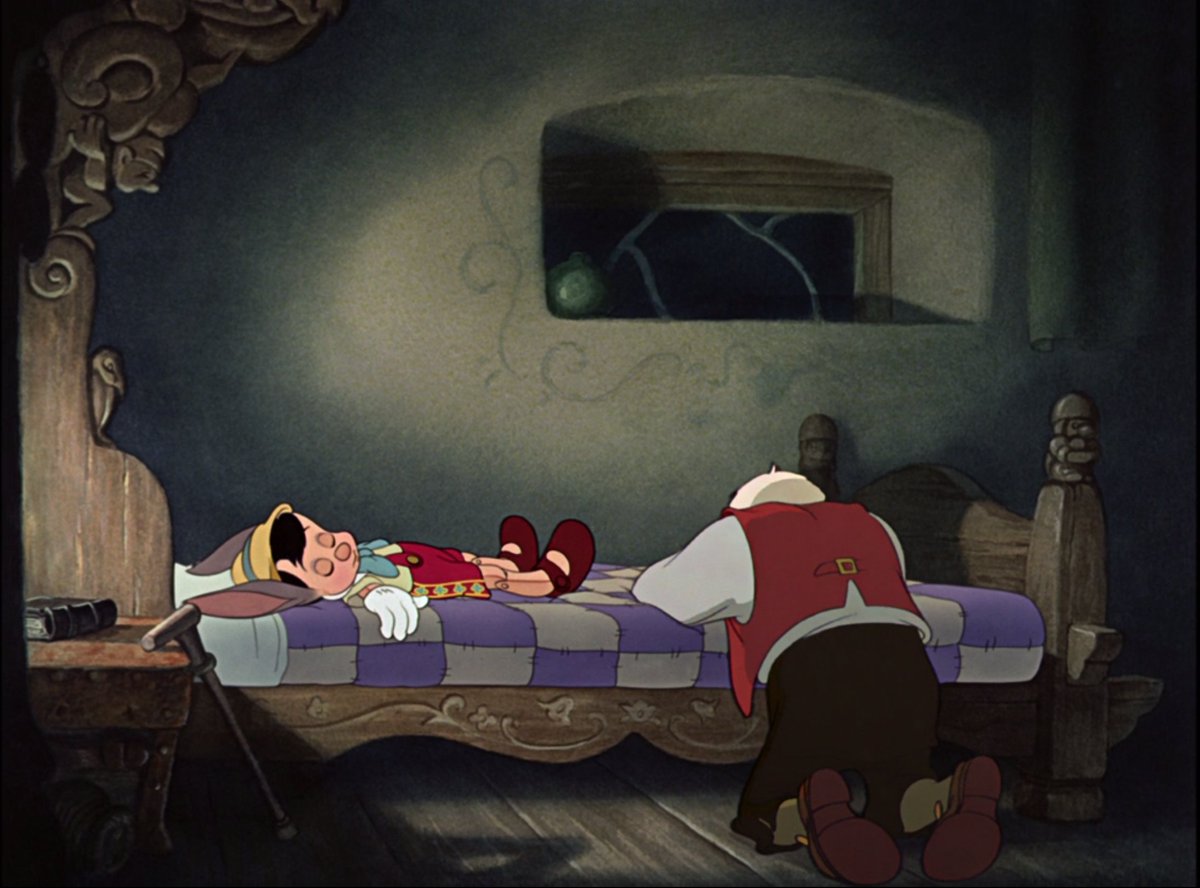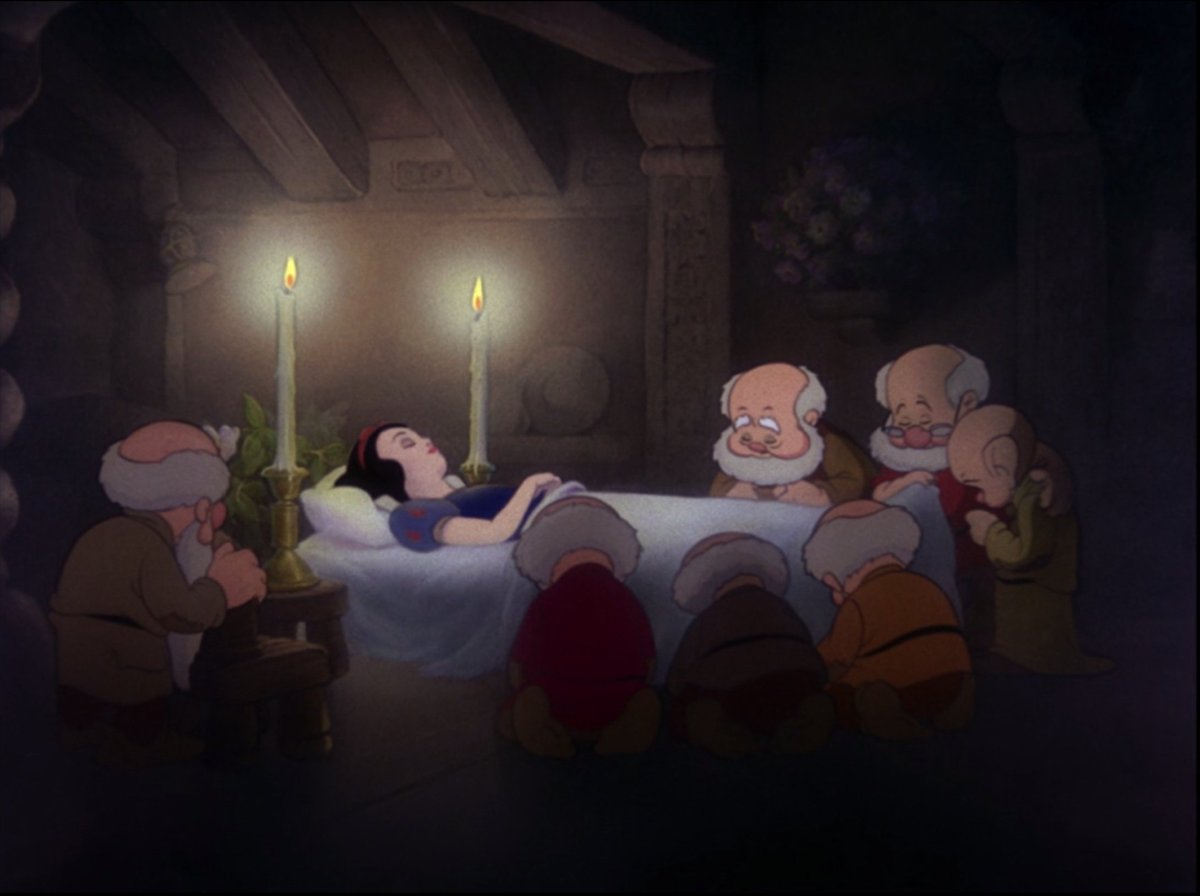"Disney+David" Episode 2: "Pinocchio" 1940. Right, so we& #39;ve covered "Snow White". Like "Toy Story", an example of one man practically willing a quantum-leap in his industry into existence using just his force of personality. Where do you go from there? Apparently, into darkness.
Walt had literally created a new medium, and he followed it up with a project that, on paper, sounded at best ambitious, at worse foolhardy: An adaptation of a macabre Italian novel boasting grim, often terrifying scenarios and a selfish, often unlikable main character...
Nowadays the name of Disney comes with it the association of a monopoly that skirts risk in favour of four-quadrant commercialism, but as the below image signifies, the early days of the Mouse House were anything but safe. Dolls don& #39;t just come to life, they can also be firewood.
In fact, the inventive ways Walt& #39;s team found to overcome, and in many instances embrace, the limitations of its dark source material would ultimately elevate it in the hearts and minds of its audience, and, in the case of this audience member, INDELIBLY so. So let& #39;s dive in...
Starting off, let& #39;s begin with the tangential: Unlike "Snow White"& #39;s opener, the book is now animated and not live action. All the better to facilitate Jiminy& #39;s magical inclusion into the framing structure (a motif wonderfully homaged in "Aladdin" with Robin Williams& #39; beggar)...
That said, Jiminy WOULD one day get the chance to cross over briefly into live action, in "Fun and Fancy Free" from 1947, where, unfortunately, he is forced to look in on a ventriloquist puppet show more terrifying than ANY scene in "Pinocchio". But& #39;s that a different thread...
The lack of live action hardly matters, though, because this is easily Disney& #39;s most exquisitely crafted (pun intended) film of his first classic run. Similar to the Dwarfs& #39; home in "Snow", we stay in Geppetto& #39;s workshop for an sizeable chunk of the movie& #39;s first act...
And, like "Snow", it compensates for this extended stay in one contained location by making it a sumptuously detailed affair. Every corner of the frame is bursting with warmth and texture and wondrous invention. When I was a kid I wanted to play with all these toys. And still do.
Also, many of these clocks are wonderfully outdated in their appropriateness. Carved scenes of hunting, slaughter, the violent disciplining of children and alcohol consumption abound! And you know what...I& #39;m good with it. I guess it& #39;s a subjective thing...
I mentioned in the previous thread the team& #39;s reliance on gags. The only notable repetition in this film is the wealth of visual gags around Jiminy interacting with all of Geppetto& #39;s clocks. It& #39;s almost like CG where they built too many assets and felt obliged to use them all!
But while we& #39;re at it, let& #39;s talk about Jiminy. He& #39;s this movie& #39;s MVP, it& #39;s secret weapon. And it& #39;s not even the fact that he& #39;s so badass that he sleeps in a box of live matches with nary a worry. He& #39;s the glue that holds every random, disparate element of the narrative together.
For one thing, he& #39;s the perfect proxy and entry point for the audience. When you& #39;re faced with a plot makes little sense you NEED a fourth-wall breaking adult character to comment on its absurdity to the audience. Which he does, constantly and hilariously....
Add to that the fact that he& #39;s a humble interloper, the smallest and most insignificant of creatures, and even then he& #39;s dressed in tramp attire. You could not find a character more everyman relatable, he& #39;s Jiminy freaking Stewart!
But what makes Jiminy a truly masterful device is how he is used to bolster the film& #39;s biggest storytelling hurdle: Pinocchio himself, a protagonist who consistently makes the wrong choices despite every other character flat-out telling him the right thing to do throughout...
I once defined dramatic storytelling as people making "wrong choices, understandably" as opposed to "right choices, boringly". And Pinocchio is a morality story where the character makes every wrong choice imaginable, but out of sheer, naive ignorance as opposed to any deep need.
Even in the face of pretty definitive experience he falls into the same deluded trap twice, and it& #39;s his newly devoted father who pays the price, going out in the rain-soaked night the first time, then getting eaten by a whale the second time. Pinocchio& #39;s an idiot, a fickle jerk.
The biggest conundrum Walt and his team faced was making the audience care about Pinocchio& #39;s plight. When your hero is two steps behind everyone else in the story, how can you be invested in him becoming a real boy, even after he& #39;s been sanded down to the cutest form imaginable?
And before I answer that question...HOLY SHIT this is the best frame in the whole gorgeous movie; I clearly have a thing for lovingly hand-painted lightning strikes. This& #39;ll become a theme, you mark my words!
The answer, unsurprisingly, is Jiminy. The cricket was a minor character in the book (who ends up getting promptly squashed by the hero). But Walt and his Story Team crafted Jiminy into the lynch-pin without which Pinocchio& #39;s character simply wouldn& #39;t work: His Conscience...
Suddenly the audience knew why they were invested in Pinocchio& #39;s fate, because Jiminy was invested. He became their proxy not simply in perceiving the narrative, but in rooting for their hero. We like Pinocchio because Jiminy likes Pinocchio. WE care because HE cares...
When he& #39;s rejected we feel angry, when he wants to give up we share his disappointment, but every time he decides to turn back around, in spite of everything, to give Pinoche another shot, we& #39;re right behind him. In that way, he& #39;s not just Pinocchio& #39;s Conscience, he& #39;s also OURS.
I& #39;ve spent a lot of time on ol& #39; Jiminy, and I have to move on, but it& #39;s important to realize his importance to the quintessential formula. From Timothy Q Mouse to the Genie to Mushu to Olaf, the scene-stealing donor character is now an essential jewel in a Disney story& #39;s crown.
But this movie is an embarrassment of riches when it comes to supporting characters. Fulfilling the requisite injection of adorable, non-English speaking critters are the odd couple of Fiagro and Cleo, a duo that endear themselves to the viewer in an effortlessly short time...
I mean, come on guys! After a relentless succession of Dwarfs defined by one characteristic repeated ad nauseum, I defy you not to fall in love with Cleo for this one dreamy spin alone. Pure economy of character, you just exactly who she is: sweet, genuine, romantic. I LOVE her.
In fact, they even get away with reusing the same "Girls, ew" and "Girls, aw shucks" progression that I groaned at in "Snow". Yes, it& #39;s an outdated arc, but I think this one lands because of the innate humour of them being two species that SHOULD hate each other. It& #39;s delightful.
You could stay in this first act all day, but one brilliant beat: Pinocchio setting himself on fire. Any great Story Team will tell you that a character& #39;s needs clear, inherent stakes and this moment is pure, real-world fear. Pinocchio burns. The world he& #39;s entering ISN& #39;T safe.
So let& #39;s see the world! I told you I& #39;d be picking my favourite mulit-plane camera move, and this one blows ANY of "Snow White"& #39;s out of the water. It& #39;s our first big look at the town after spending 25 minutes in Geppetto& #39;s workshop, and Walt treats us to a 45 second EPIC...
It glides from the bell-tower, through birds, into the town, then THROUGH the town, following countless character vignettes before finally landing on Geppetto& #39;s front door. It& #39;s the "camera swooping through Isengard" of this movie, and I am here for it! Expansive film-making.
It& #39;s also where we meet the first of this movie& #39;s very bad apples who lead "Pinocchio" astray. Foulfellow and Gideon also grace us with possibly the best double-take in any animated film ever. My mates and have quoted countless times, devoid of context, it& #39;s that good:
"Pinocchio" is about being unselfish and exercising good judgement. But where I think it actually excels, where it burrows itself permanently in children& #39;s psyches, is its disquieting revelation that bad people are out there (accepting the odd culturally insensitive stereotype).
Like Aesop& #39;s fables and "Mother Goose" tales, there is a utility in preparing kids for the wider world. And "Pinocchio" even goes a step further by depicting not simply a litany of bad actors, but GRADATIONS of bad, occupying different levels of immorality to each other...
Like Aesop fables and "Mother Goose" tales, there is utility in preparing children for hardship; for hustlers, kidnappers and monsters. As Bernice Cullinan once wrote: "Small children live in a world of giants, they have fears and these tales give them the courage to grow up."
They also teach children that "Red Lobster", even back then, was a wretched hive of scum and villainy. And it leads to easily the most retrospectively controversial portion of the movie, with Pinocchio submitting himself to the avarice and sin of "Please Island"...
Speaking of, unnecessary observation tangent: Even though it makes no temporal or literal sense, this wayward youth is played by William H. Macy and that is a fact.
I can fully understand why parents would want a tobacco warning on a film like this, but it does amaze how subjective my tolerance for certain imagery is. As problematic as this segment is, Pinocchio is clearly depicted being horrified at what these drugs do and discarding them.
And I defy ANY child to want to take a toke on a cigar after watching this horrifying transformation. It& #39;s a nightmarishly boarded sequence that retains its punch to this day. This kid literally cries out for his mother with his last human breath, it& #39;s TRAUMATIZING. Disney, safe?
This time round my Story gaze did notice one major difference from the modern Hollywood note system. No executive would ever allow Pinocchio and Jiminy off the island without first rescuing the other boys, or AT LEAST setting them free from their cages. Their fate remains sealed.
Another lovely (literally pitch black) nuance is Disney& #39;s decision to keep the Coachmen& #39;s henchmen as shadowy, non-specific silhouettes. Their shape doesn& #39;t even seem human, almost void-like. And the Coachmen is fully visible next to them, so it& #39;s an eerily conscious choice...
They actually bring to mind the similarly eerie, almost supernatural henchmen from "Belleville Rendezvous". There is a tendency in our current film-making ethos towards excessive internal logic, but I really love it when a director willfully chooses NOT to explain something.
And that brings us to the final Act, and the one clumsy plot device in the film: The Blue Fairy& #39;s Magical Dove of Vital Exposition. By this point the Story Team had clearly exhausted their ways to organically get Pinoche from A to B, and the belly of a whale was a bridge too far.
But WHAT A WHALE. The way Monstro just bleeds, ghost-like, out of the murk, no fanfare, no movement, just him on the ocean floor, so titanic that he& #39;s literally answerable to no-one. What an astonishing elemental force of a villain...
Yes, it& #39;s a jarring left-turn, plot-wise yes it makes little to no sense, but my God this is what animation was invented for. And really Monstro is the natural progression of the theme. If each antagonist represents a different class of predator, meet the top of the foodchain...
It also segues us into a new segment of this tweet thread I have decided to call "Water. Lots of Water. Just Beautiful Shots of Thousands Of Hand-Animated Droplets of Water." Ohhhh, the water porn in this finale. Just. LOOK. AT. IT.
Two thoughts before I let the, erm, floodgates open...One: It& #39;s genuinely weird that Cleo has no problem with either Geppetto catching fish OR Figaro chowing down on one in front of her. Is there a fish caste system? Granted, this IS a universe where fish apparently eat cake...
Second, this is the first viewing where I& #39;ve actually spotted a missed Story opportunity, one that would never get lost today: Pinnochio is faced with either telling the truth or lying to Geppetto about how he became part-donkey, but his father cuts him off before he can choose.
Up till now I had never thought about the fact that Pinocchio& #39;s nose only grows in ONE scene of this film and never reprises. Geppetto bailing his son out of actually proving how far he& #39;s matured is a decision we just wouldn& #39;t make today. He gotta put his money where his nose is!
Oh, but who can complain, when the ending is this grand? Did I mention the DROPLETS OF WATER??? Every time I watch this film I am transported to a very specific point in time, being about six years old seeing this in a cinema in Palo Alto, California....
Believe it or not kids, this was my first EVER memory of watching a film in a theater. You see, it was this film (but specifically, this sequence with Monstro) that first ignited my love of cinema, my awe at film-making, and my desire to be a part of it somehow....
Even as a child I intuitively understood that that water, those countless, STUNNING droplets of water, were drawn by someone& #39;s hand. The tactile, tangible quality of cell animation meant that it wasn& #39;t unknowable like a computer render, this was something I COULD DO...maybe.
It would take me a long time, down many different roads, to get to where I am today. Through cartooning, through film school, BACK to cartooning, then through illustration and writing, and then full circle with animation...but it all started right here in the belly of this whale.
Hold on! INSANELY beautiful water droplet CLIMAX:
And if that sequence was not incredible enough, it has the perfect button, washing Figaro and Cleo safely ashore in a crowd-pleasing gag that speaks to a fundamental truth about internal logic: If we want something badly enough, make giving it to us the joke.
Right, let& #39;s wrap this up. Admittedly Walt is retreading previous emotional terrain here with the deathbed vigil around a soon-to-be-resurrected hero. But at least this time said hero has actually earned his right to be brought back by the deux-ex-machina. An actual ARC...
I realize, with all I had to go through in this review, that I couldn& #39;t spare any time for Geppetto, but he too is hilariously sketched as a character. Him telling Pinocchio to lie back down because "you& #39;re dead" is a 24-carat gold zinger right after the saddest beat. Perfection.
And, this being only the second animated feature in all of history, it& #39;s amazing to see how fully realized and confident the final scene bookends with the first scene. We& #39;re in the workshop, the clocks are back on, we return to equilibrium for the sendoff...
Dovetailing the ending back into the beginning is a trope that now feels like the very definition of formula. In fact, in far too many animated films it feels rote and obligatory. But this feels cozy and right, with even Jiminy commenting on it before returning to the window.
All that& #39;s left is to crown our audience stand-in, the guy who taught us to root the kid to be a real boy, with an honorary medal. Pinocchio may have had the arc, but this was Jiminy& #39;s story. That& #39;s why he gets both the beginning and the end...
And to wrap this bookend up in one final bow, sings us out with the (checks notes) ACADEMY AWARD-WINNING song "When You Wish Upon A Star". And fade out...
Aaaaand exhale. It should be no surprise to any of you, both by the length of this thread and the sheer volume of gifs, that this movie holds a special and formative place in my heart. Every viewing only reaffirms its value to me, as a Story guy and a lover of cinema in general.
For a difficult second album it& #39;s admirably brave and mind-bogglingly ambitious in its conception. Walt could retreated to the relative safety of another princess story (as he would later on) but instead he doubled down on the ground-breaking innovation. On RISK.
And that risk, it would turn out, was not to pay off in the way he had hoped. The movie& #39;s box office would ultimately be hobbled by the dawn of WW2, the beginning of a period that would mire the studio in compromises while Walt was approaching the height of his creative power...
It would eventually be rereleased and reclaimed, to hook young impressionable youths like me...but not on the reefer and booze, you understand? On those stunning, pearlescent waves, every droplet immaculately painted onto every cell. You know...the GOOD STUFF!
As far as reviews go this is a peerless, monumental piece of animation technically. There are elements one could pick at, a lead we have to strain to sympathize with, arguably objectionable and frightening content for some, with a few outdated depictions of race and gender.
That being said, it is impossible for me to separate this film in my mind from the transformative experience I had first watching it, and, frankly, I don& #39;t much want to. Walt Disney refused to rest on his laurels after an unbelievable success, and created a sophomore classic.
And decades after his death, he helped set a young David Trumble on a career trajectory that brought him back to the loving, at times maddening, arms of animation. I may never work at Disney Animation Studios, but this movie gave me a job.
Final stats:
Viewer Score: High 5 (Out of 5)
Problematic Score: Mid 3 (Out of 5)
Verdict: This was no flash in the pan.
Viewer Score: High 5 (Out of 5)
Problematic Score: Mid 3 (Out of 5)
Verdict: This was no flash in the pan.

 Read on Twitter
Read on Twitter
